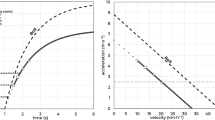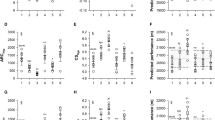Abstract
Tetris is a complex task which taps into several human skills: among them perceptual learning, planning, motor skills, and sequential decision-making. Following a divide-and-conquer strategy, we adopt a machine modeling approach to isolate the contribution of sequential decision-making from the other three skills. In two studies, we test three sets of 1,771,561 feature-based machine players (MPs) (116, 11 weights for each of 6 features) of Tetris for both long-running (tortoise) and short-running (hare) MPs. Tortoise models run until they die. Hare models are stopped after 506 episodes. For both studies, we select the longest running tortoise model and compare its score and behavior with that of the best scoring hare model. The best tortoise models adopt an endurance strategy which emphasizes single-line over multi-line clears. The best hare models adopt an escalation strategy which stresses multi-line clears. In contrast, our human players tend to adopt the escalation strategy early in their game but switch to the endurance strategy as speed demands increase. Unexpectedly, across three model runs, each with a different random seed, we obtain three different sets of “best fitting” models, that is, the MPs overfit the data even though that data is generated by an essentially infinite random sequence. However, in each model run, the best tortoise adopted the endurance strategy and the best hare adopted escalation.



Similar content being viewed by others
Notes
Attempting to keep, say, the right-most column clear while completely filling up the first four rows of the other nine columns is a common, human tactic. This configuration allows the right-most column to be plugged by an I-beam zoid, clearing four lines at once, and is called “a Tetris.” However, building this configuration requires getting zoids that would leave pits (e.g., see Fig. 2) if placed in the first four rows out of the way, by placing them on the left-side of the top of the growing pile, while using other pieces to build the “four high wall,” then waiting for the I-beam to appear, and finally placing the I-beam into the (at least) 4 deep slot, after that wall is built.
The number of alternative possible placements for a zoid varies with the zoid type and with the current state of the board; however, for an empty board, there are 9 positions where the square zoid can be placed, 17 positions where the Z-, S-, and I-beam can be placed, and 34 positions where the L-, J-, and T- can be placed. Hence, the “average” zoid in an unconstrained board can be placed in any one of 23 locations.
Note that the authors disagree among themselves as to whether this use of the term “strategy” is strictly appropriate; however, at least for now, we cannot find a better one.
References
Anderson, J. R. (1991a). Is human cognition adaptive? Behavioral and Brain Sciences, 14(3), 471–517.
Anderson, J. R. (1991b). The place of cognitive architectures in a rational analysis. In K. VanLehn (Ed.). Architectures for intelligence (Chap. 2, Vol. 22, pp. 1–24). Hillsdale, NJ: Lawrence Erlbaum Associates.
Baccherini, D., & Merlini, D. (2008). Combinatorial analysis of Tetris-like games. Discrete Mathematics, 308(18), 4165–4176. https://doi.org/10.1016/j.disc.2007.08.009.
Brzustowski, J. (1992). Can you win at tetris? (Master’s thesis, University of British Columbia, Vancouver, BC, Canada).
Burgiel, H. (1997). How to lose at Tetris. The Mathematical Gazette, 81 (491), 194–200. Retrieved from http://www.jstor.org/stable/pdfplus/3619195.pdf
Fahey, C. P. (2015). Tetris AI. [Online; accessed 2015-Jan-30]. Retrieved from http://www.colinfahey.com/tetris/
Gabillon, V., Ghavamzadeh, M., & Scherrer, B. (2013). Approximate dynamic programming finally performs well in the game of Tetris. In Advances in neural information processing systems (Vol. 26, pp. 1754–1762). Retrieved from http://media.nips.cc/nipsbooks/nipspapers/paper_files/nips26/881.pdf
Glendenning, K., Wischgoll, T., Harris, J., Vickery, R., & Blaha, L. (2016). Parameter space visualization for large-scale datasets using parallel coordinate plots. Journal of Imaging Science and Technology, 60(1), 104061–104068. https://doi.org/10.2352/ImagingSci.Technol.2016.60.1.010406.
Gluck, K. A. & Harris, J. (2008). Mindmodeling@home. In B. C. Love, K. McRae, & V. M. Sloutsky (Eds.). Proceedings of the 30th annual conference of the cognitive science society (p. 1422). Cognitive Science Society.
Gray, W. D. (2017). Games-XP: action games as cognitive science paradigm. Topics in Cognitive Science, 9(2), 289–307. https://doi.org/10.1111/tops.12260.
Hick, W. E. (1952). On the rate of gain of information. The Quarterly Journal of Experimental Psychology, 4, 11–26. https://doi.org/10.1080/17470215208416600.
Holmes, E. A., James, E. L., Coode-Bate, T., & Deeprose, C. (2009). Can playing the computer game “Tetris” reduce the build-up of flashbacks for trauma? A proposal from cognitive science. PLoS One, 4(1), e4153. https://doi.org/10.1371/journal.pone.0004153.
Jensen, A. R. (1987). Individual differences in the Hick paradigm. In P. A. Vernon (Ed.), Speed of information processing and intelligence (pp. 101–175). Norwood, NJ: Ablex.
Lindstedt, J. K., & Gray, W. D. (2015). Meta-T: Tetris as an experimental paradigm for cognitive skills research. Behavior Research Methods., 47, 945–965. https://doi.org/10.3758/s13428-014-0547-y.
Lindstedt, J. K., & Gray, W. D. (2018). Distinguishing experts from novices by the mind’s hand and mind’s eye. In Manuscript submitted for publication.
Martin-Gutierrez, J., Luis Saorin, J., Martin-Dorta, N., & Contero, M. (2009). Do video games improve spatial abilities of engineering students? International Journal of Engineering Education, 25(6, SI), 1194–1204.
Mayer, R. E. (2014). Computer games for learning: an evidence-based approach. Cambridge, MA: MIT Press.
Sibert, C., Gray, W. D., & Lindstedt, J. K. (2017). Interrogating feature learning models to discover insights into the development of human expertise in a real-time, dynamic decision-making task. Topics in Cognitive Science, 9, 1–21. https://doi.org/10.1111/tops.12225.
Simon, H. A. (1991). Cognitive architectures and rational analysis: comment. In K. VanLehn (Ed.), Architectures for intelligence (Vol. 22, pp. 25–39). Hillsdale, NJ: Lawrence Erlbaum Associates.
Simon, H. A. (1992). What is an “explanation” of behavior? Psychological Science, 3(3), 150–161.
Şimşek, Ö., Algorta, S., & Kothiyal, A. (2016). Why most decisions are easy in tetris—and perhaps in other sequential decision problems, as well. In Proceedings of the 33rd international conference on machine learning (pp. 1757–1765). JMLR.
Stafford, T., & Dewar, M. (2014). Tracing the trajectory of skill learning with a very large sample of online game players. Psychological Science, 25(2), 511–518. https://doi.org/10.1177/0956797613511466.
Stuart, K. (2010). Tetris and Snake - the biggest games in the world. The Guardian. Retrieved October 20, 2012, from http://gu.com/p/2e2kk/em
Szita, I., & Lorincz, A. (2006). Learning Tetris using the noisy cross-entropy method. Neural Computation, 18(12), 2936–2941.
Terlecki, M. S., Newcombe, N. S., & Little, M. (2008). Durable and generalized effects of spatial experience on mental rotation: gender differences in growth patterns. Applied Cognitive Psychology, 22(7), 996–1013.
Thiery, C., & Scherrer, B. (2009a). Building controllers for Tetris. ICGA Journal, 32, 3–11 Retrieved from http://hal.archives-ouvertes.fr/inria-00418954/.
Thiery, C., & Scherrer, B. (2009b). Improvements on learning Tetris with cross-entropy. ICGA Journal, 32(1), 23–33.
Support Information
Wayne Gray received grant (N00014-17-1-2943) from the Office of Naval Research, Dr. Ray Perez, Project Officer.
Author information
Authors and Affiliations
Contributions
Sibert and Gray conceived and designed the study and wrote the manuscript. Sibert did the modeling and data analyses. Gray and Sibert discussed the results and elaborated the theoretical implications of the results.
Corresponding author
Additional information
Publisher’s Note
Springer Nature remains neutral with regard to jurisdictional claims in published maps and institutional affiliations.
Electronic Supplementary Material
Appendix Table 1
(DOCX 12 kb)
Rights and permissions
About this article
Cite this article
Sibert, C., Gray, W.D. The Tortoise and the Hare: Understanding the Influence of Sequence Length and Variability on Decision-Making in Skilled Performance. Comput Brain Behav 1, 215–227 (2018). https://doi.org/10.1007/s42113-018-0014-4
Published:
Issue Date:
DOI: https://doi.org/10.1007/s42113-018-0014-4




